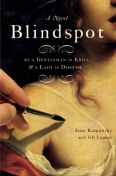BKMT READING GUIDES
Blindspot: A Novel
by Jane Kamensky, Jill Lepore
Hardcover : 512 pages
1 club reading this now
2 members have read this book
Introduction
Written with wit and exuberance by longtime friends and accomplished historians, Blindspot is at once fiction and history, mystery and love story, tragedy and farce. Set in boisterous, rebellious Boston on the eve of the American Revolution, it ingeniously weaves together the fictional stories of a Scottish portrait painter and notorious libertine Stewart Jameson, and Fanny Easton, a fallen woman from one of Boston’s most powerful families who disguises herself as a boy to become Jameson’s defiant and seductive apprentice, Francis Weston. When Boston’s revolutionary leader, Samuel Bradstreet, dies suddenly on the day Jameson is to paint his portrait, Bradstreet’s slaves are accused of murder. Jameson, Weston, and Jameson’s friend, the brilliant African-born Oxford-educated doctor Ignatius Alexander, set out to determine the truth. What they discover turns topsy-turvy everything you thought you knew about the Founding Fathers. Peopled not only with the celebrated Sons of Liberty but also with revolutionary Boston’s unsung inhabitants—women and servants, hawkers and rogues and pickpockets—Blindspot is both prodigiously learned and lush with the bawdy sensibility of the eighteenth century. It restores the humanity, the humor, and the sex to the story of the American Revolution.
Excerpt
chapter 3In Which Promise Arrives, and Promises Are Made
sitter, a sitter, my kingdom for a sitter! I have stocked my painting room with pigments and spirits and oils, purchased dear, on ac¬count, from the apothecary whose shop is but two doors down. Yet, in near a month on these shores, all the Art I have undertaken hardly mer¬its the name: I have painted a wooden shop sign, no more than crude line work: the words STEWART JAMESON, FACE-PAINTER above a head- and-shoulders of a bewigged gentleman in a velvet cloak. The painter's arms now hang outside my door, like a lure tied to a hook, dangling in so much still water. Have I crossed an ocean to sit by a pond? Reader, I am no an¬gler; I am a painter. And mark me: a painter must paint. How dearly I wish that you, Sir-or perchance, Madam-were here with me this very instant, sitting for your portrait. Then we could truly take each other's measure. But no. There you perch, in your easy chair, reading by candle¬light, while I, at my desk, scribble alone. ...
Discussion Questions
1. In her letters to her childhood friend Elizabeth, Fanny Easton bemoans the limits placed upon female education and ambition. What constraints shaped Fanny's life as a woman, and to what extent did she successfully escape them by posing as Francis Weston? How different were the expectations governing American women's lives in the eighteenth century? What could Jameson do that Fanny couldn't?2. How do the people in Blindspot view the profession of the portrait-painter? Is Jameson an artist or an artisan? What kinds of connections do the authors draw between Jameson's paintings and the patriot politics of the Friends of Liberty? Is Jameson's art itself revolutionary?
3. Jameson's longtime friend, Ignatius Alexander, confronts Blindspot's narrators and readers with the paradox of slavery in the land that cried for liberty, a paradox well recognized in the 1760s. How well do Jamie and Fanny understand Sander's world, and his vision? What are their blind spots? Why do you think the authors chose to tell Sander's story through Jamie's and Fanny's voices, and why does the doctor resist telling his own story?
Notes From the Author to the Bookclub
Dear Reader, We're history professors, and one of the things we most love about our work is solving the puzzles of the past by reading very old documents: newspapers, diaries, court records, even love letters. Our novel, Blindspot, gives readers the chance to be historians, too. Set in Boston on the eve of the American Revolution, Blindspot interleaves real documents, like clippings from the Boston Gazette, with fictional ones: the memoirs of Stewart Jameson, a Scottish portrait painter escaped from debtor's prison; and the letters of Fanny Easton, a fallen woman who disguises herself as a boy to become Jameson's apprentice. A history of ordinary people caught in an extraordinary time, Blindspot's also an affectionate send-up of eighteenth-century fiction, mixing the romping, bawdy, pre-modern sensibility of Jonathan Swift and Benjamin Franklin with the modern passion for the past that inspires readers of A.S. Byatt, E. L. Doctorow, and Jeanette Winterson. Working together on Blindspot made us laugh, sometimes made us cry, and even made us blush. We hope it reaches you that way, too.Book Club Recommendations
Recommended to book clubs by 1 of 2 members.
Book Club HQ to over 90,000+ book clubs and ready to welcome yours.
Get free weekly updates on top club picks, book giveaways, author events and more








